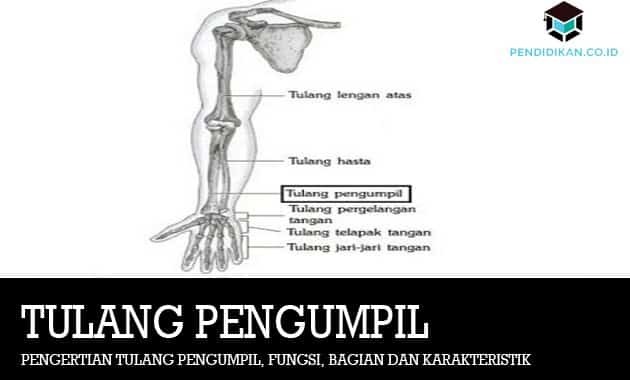Definition of the Forearm Bone, Function, Part & Characteristics
Education. Co. Id – This time we will discuss about the forearm bone, an explanation of this forearm bone will be described in full as follows:

Definition of the Collector Bone
The lever bone is a rod whose two ends are shorter than the ulna which is located on the lateral side of the forearm. The lever bone is also known as the radius. The radius itself is the bone that composes the forearm with the ulna.
The lever bone is a propulsion device located at the top that connects the elbow and the thumb. Earbone (RadiusThis is a type of bone that makes up the forearm.
On the inside of the collecting bone there is bone marrow. The ulna and the lever bone are tubular bones, the length and the ends are large and there are cavities. At the end of the lever bone is attached to a muscle whose function is to move the forearm.
Functions of the scapula
Below are the functions of the collector, including the following:
- As a bone whose role is to move the upper body.
- As a bone whose function is to connect the elbow joint and also the thumb or thumb
- As a bone whose role is to compose the forearm
- The place where the arm muscles attach
- Parallel to the ulna
- forearm reinforcement
- Regulate the movement of the lower hand
- Play the role of moving the finger
- Elbow movement controller
- Connecting the finger to the bone of the upper arm
- Lower arm builder
- Located in the bone marrow
- As a pedestal for arm reinforcement
Based on its function, the lever bone is assisted by the presence of the ulna. The two bones have the size of a pipe, and are long and on the side enlarged ends and has a cavity in the middle of the bone that is shaped like a pipe. In the center of the cavity, there is a bone marrow.
The end of the ulna and the lever bone will attach to a muscle whose function is to: to move the forearm which will move up and down with the hinge joint which is located at elbow. One of these ulna and lever bones automatically attaches to a bone the upper arm, the fibers of the other end of the forearm bone are attached to a wrist bone hand.
Parts of the ossicles
Bone is a connective tissue consisting of cells, fibers and an extracellular matrix. The bone matrix is a hard textured part that is located in the outermost layer of bone, and the matrix occurs matriks This is due to the deposition of minerals in the bone, so that the bone also undergoes calcification so that the bone matrix is formed that.
Based on its function, the workings of the lever bone when the central nervous system conducts a stimulus is known as an action potential. This action potential will be delivered to the motor nerve cell and then the motor nerve cell secretes a chemical element called Acetylcholine, then binds to the receptor by passing through the muscle surface, it produces a reaction in each muscle work.
Below are some of the muscles that are attached to the lever bone, including the following:
- The pronator teres muscle
- Pronator quadratus muscle
- Brachioradialis muscle
- The abductor pollicis longus muscle
- Extensor pollicis brevis muscle
- The flexor digitorum superficialis muscle
- The flexor pollicis longus muscle
- Biceps brachii muscle
- supinator muscle
In children who are 4 years old, bone growth starts from the middle of the head of the bone. At the age of 10 years, there was growth in the olecranon. And at the age of 16 years, the superior part of the bone has completely fused with the humerus, and at the bottom it occurs at the age of about 20 years.
Characteristics of the Bones of the Grasshopper
The shape of this bone is long and like a pipe and at the end it is an enlarged cavity. This part of the bone is composed of bone marrow which contains blood, blood vessels and protein. This bone marrow consists of red bone marrow and yellow bone marrow. This red bone marrow is for the formation of red blood cells while for this yellow bone marrow is to form white blood cells.
The Process of the Collector Bone
When the central nervous system conducts a stimulus known as an "action potential", then the action potential is sent to the motor nerve cell. and after that the motor nerve cells secrete a chemical called acetylcholine, after that communicates with the receptor via a muscle surface, thereby producing a reaction in each muscle work.
When acetylcholine binds to the receptor, this is where the contraction process occurs, causing sodium ions to enter the membrane into the cytoplasm where it there is a release of calcium ions which make it diffuse in the muscle fibers which makes the protein bonds in the muscle cells change and then the process occurs. contraction.
When the impulses from the central nervous system stop, the chemical reactions that occur in the muscles also stop, causing the muscles to relax again.
Thus an explanation of the meaning of the forearm bone, its functions, parts and characteristics, hopefully what is described can be useful for you.
See AlsoUnderstanding Money, Functions, Terms, Characteristics, and Types
See AlsoUnderstanding Debate, Objectives, Characteristics, Benefits, Types, and Elements
See AlsoUnderstanding Pancasila Ideology, Functions, Meanings, Dimensions and Values
